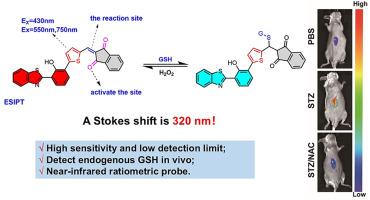基于esipt的近红外比例可逆荧光探针用于糖尿病模型谷胱甘肽动态原位监测
IF 4.2
3区 工程技术
Q2 CHEMISTRY, APPLIED
引用次数: 0
摘要
谷胱甘肽(GSH)是一种重要的抗氧化剂,与包括糖尿病在内的多种疾病密切相关。准确和动态监测谷胱甘肽水平对有效的临床诊断至关重要。尽管已经开发了许多用于谷胱甘肽检测的荧光探针,但传统的不可逆单通道探针存在几个明显的局限性,例如不可避免的激发-发射串扰,缺乏自校准能力,以及无法区分慢性耗尽和瞬态波动。为了解决这些问题,我们开发了一种可逆的比值型谷胱甘肽探针,名为BBTD。该探针利用2-(2-羟基苯基)苯并噻唑(HBT),一种基于激发态分子内质子转移(ESIPT)的荧光团,并将1h -茚-1,3(2H)-二酮作为谷胱甘肽的Michael加成位点。在这些组分之间引入了噻吩单元以扩展共轭体系并将发射波长移至近红外区域。探针BBTD对GSH具有可逆、比例、高灵敏度(检测限为0.23 μM)和大的Stokes位移响应,基于esipt的发射可达750 nm (Stokes位移为320 nm, HBT-COU为621 nm),非常适合实时监测GSH的体内波动。在糖尿病模型中,BBTD有效地量化了肝脏中谷胱甘肽的消耗,并评估了n -乙酰半胱氨酸(NAC)的治疗效果。本文章由计算机程序翻译,如有差异,请以英文原文为准。

An ESIPT-based near-infrared ratiometric reversible fluorescent probe for dynamic in situ monitoring of glutathione in diabetic models
Glutathione (GSH) is a critical antioxidant that is closely associated with a variety of diseases, including diabetes. Accurate and dynamic monitoring of GSH levels is essential for effective clinical diagnosis. Although numerous fluorescent probes have been developed for GSH detection, traditional irreversible single-channel probes suffer from several significant limitations, such as unavoidable excitation-emission crosstalk, the absence of self-calibration capability, and the inability to differentiate between chronic depletion and transient fluctuations. To address these challenges, we developed a reversible ratiometric GSH probe named BBTD. This probe utilized 2-(2-hydroxyphenyl)benzothiazole (HBT), a fluorophore based on excited-state intramolecular proton transfer (ESIPT), and incorporated 1H-indene-1,3(2H)-dione as the Michael addition site for GSH. A thiophene unit was introduced between these components to extend the conjugated system and shift the emission wavelength into the near-infrared region. Probe BBTD exhibited reversible, ratiometric, highly sensitive (Detection limit: 0.23 μM) and large Stokes shift responses to GSH, with ESIPT-based emission reaching up to 750 nm (Stokes shift: 320 nm; HBT-COU: 621 nm), making it highly suitable for real-time in vivo monitoring of GSH fluctuations. In a diabetes model, BBTD effectively quantified GSH depletion in the liver and assessed the therapeutic efficacy of N-acetylcysteine (NAC).
求助全文
通过发布文献求助,成功后即可免费获取论文全文。
去求助
来源期刊

Dyes and Pigments
工程技术-材料科学:纺织
CiteScore
8.20
自引率
13.30%
发文量
933
审稿时长
33 days
期刊介绍:
Dyes and Pigments covers the scientific and technical aspects of the chemistry and physics of dyes, pigments and their intermediates. Emphasis is placed on the properties of the colouring matters themselves rather than on their applications or the system in which they may be applied.
Thus the journal accepts research and review papers on the synthesis of dyes, pigments and intermediates, their physical or chemical properties, e.g. spectroscopic, surface, solution or solid state characteristics, the physical aspects of their preparation, e.g. precipitation, nucleation and growth, crystal formation, liquid crystalline characteristics, their photochemical, ecological or biological properties and the relationship between colour and chemical constitution. However, papers are considered which deal with the more fundamental aspects of colourant application and of the interactions of colourants with substrates or media.
The journal will interest a wide variety of workers in a range of disciplines whose work involves dyes, pigments and their intermediates, and provides a platform for investigators with common interests but diverse fields of activity such as cosmetics, reprographics, dye and pigment synthesis, medical research, polymers, etc.
 求助内容:
求助内容: 应助结果提醒方式:
应助结果提醒方式:


